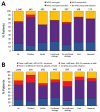Management of Central Nervous System Infections, Vientiane, Laos, 2003-2011
- PMID: 31002063
- PMCID: PMC6478220
- DOI: 10.3201/eid2505.180914
Management of Central Nervous System Infections, Vientiane, Laos, 2003-2011
Abstract
During 2003-2011, we recruited 1,065 patients of all ages admitted to Mahosot Hospital (Vientiane, Laos) with suspected central nervous system (CNS) infection. Etiologies were laboratory confirmed for 42.3% of patients, who mostly had infections with emerging pathogens: viruses in 16.2% (mainly Japanese encephalitis virus [8.8%]); bacteria in 16.4% (including Orientia tsutsugamushi [2.9%], Leptospira spp. [2.3%], and Rickettsia spp. [2.3%]); and Cryptococcus spp. fungi in 6.6%. We observed no significant differences in distribution of clinical encephalitis and meningitis by bacterial or viral etiology. However, patients with bacterial CNS infection were more likely to have a history of diabetes than others. Death (26.3%) was associated with low Glasgow Coma Scale score, and the mortality rate was higher for patients with bacterial than viral infections. No clinical or laboratory variables could guide antibiotic selection. We conclude that high-dependency units and first-line treatment with ceftriaxone and doxycycline for suspected CNS infections could improve patient survival in Laos.
Keywords: Asia; Cryptococcus; Japanese encephalitis virus; Lao; Laos; Leptospira; Orientia tsutsugamushi; Rickettsia; WHO encephalitis; WHO meningitis; antibiotics; antimicrobial medicines; bacteria; bacterial infections; central nervous system infections; diabetes; encephalitis; meningitis; meningitis/encephalitis; mortality; patient care management; viral infections; viruses.
Figures




Similar articles
-
Spatial epidemiology of Japanese encephalitis virus and other infections of the central nervous system infections in Lao PDR (2003-2011): A retrospective analysis.PLoS Negl Trop Dis. 2020 May 26;14(5):e0008333. doi: 10.1371/journal.pntd.0008333. eCollection 2020 May. PLoS Negl Trop Dis. 2020. PMID: 32453806 Free PMC article.
-
Orientia, rickettsia, and leptospira pathogens as causes of CNS infections in Laos: a prospective study.Lancet Glob Health. 2015 Feb;3(2):e104-12. doi: 10.1016/S2214-109X(14)70289-X. Lancet Glob Health. 2015. PMID: 25617190 Free PMC article.
-
A prospective assessment of the accuracy of commercial IgM ELISAs in diagnosis of Japanese encephalitis virus infections in patients with suspected central nervous system infections in Laos.Am J Trop Med Hyg. 2012 Jul;87(1):171-178. doi: 10.4269/ajtmh.2012.11-0729. Am J Trop Med Hyg. 2012. PMID: 22764310 Free PMC article.
-
Central Nervous System Infections.Prim Care. 2018 Sep;45(3):505-518. doi: 10.1016/j.pop.2018.05.007. Epub 2018 Jul 9. Prim Care. 2018. PMID: 30115337 Review.
-
Laboratory diagnosis of CNS infections in children due to emerging and re-emerging neurotropic viruses.Pediatr Res. 2024 Jan;95(2):543-550. doi: 10.1038/s41390-023-02930-6. Epub 2023 Dec 2. Pediatr Res. 2024. PMID: 38042947 Review.
Cited by
-
Neurological Facets of Scrub Typhus: A Comprehensive Narrative Review.Ann Indian Acad Neurol. 2021 Nov-Dec;24(6):849-864. doi: 10.4103/aian.aian_739_21. Epub 2021 Dec 17. Ann Indian Acad Neurol. 2021. PMID: 35359522 Free PMC article.
-
Immunoglobulin M seroneutralization for improved confirmation of Japanese encephalitis virus infection in a flavivirus-endemic area.Trans R Soc Trop Med Hyg. 2022 Nov 1;116(11):1032-1042. doi: 10.1093/trstmh/trac036. Trans R Soc Trop Med Hyg. 2022. PMID: 35593182 Free PMC article.
-
Neurological Manifestations of Scrub Typhus.Curr Neurol Neurosci Rep. 2022 Aug;22(8):491-498. doi: 10.1007/s11910-022-01215-5. Epub 2022 Jun 21. Curr Neurol Neurosci Rep. 2022. PMID: 35727462 Review.
-
Spatial epidemiology of Japanese encephalitis virus and other infections of the central nervous system infections in Lao PDR (2003-2011): A retrospective analysis.PLoS Negl Trop Dis. 2020 May 26;14(5):e0008333. doi: 10.1371/journal.pntd.0008333. eCollection 2020 May. PLoS Negl Trop Dis. 2020. PMID: 32453806 Free PMC article.
-
Next-generation sequencing in the diagnosis of neurobrucellosis: a case series of eight consecutive patients.Ann Clin Microbiol Antimicrob. 2023 Jun 2;22(1):44. doi: 10.1186/s12941-023-00596-w. Ann Clin Microbiol Antimicrob. 2023. PMID: 37268917 Free PMC article.
References
-
- World Health Organization. Japanese encephalitis. 2015. Dec 31 [cited 2018 Jun 6]. https://www.who.int/en/news-room/fact-sheets/detail/japanese-encephalitis
Publication types
MeSH terms
Grants and funding
LinkOut - more resources
Full Text Sources
Miscellaneous

